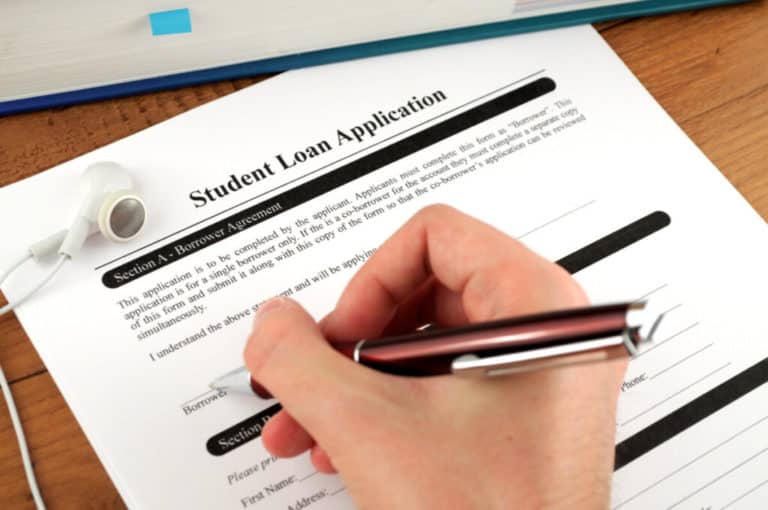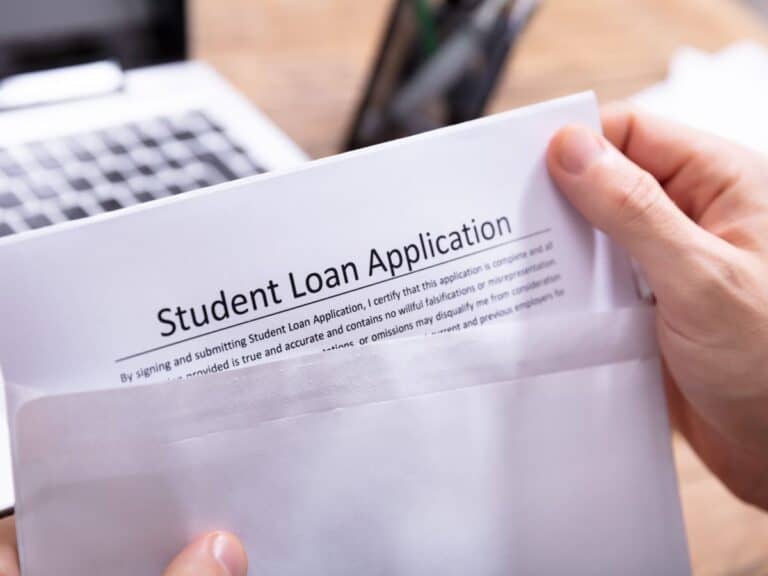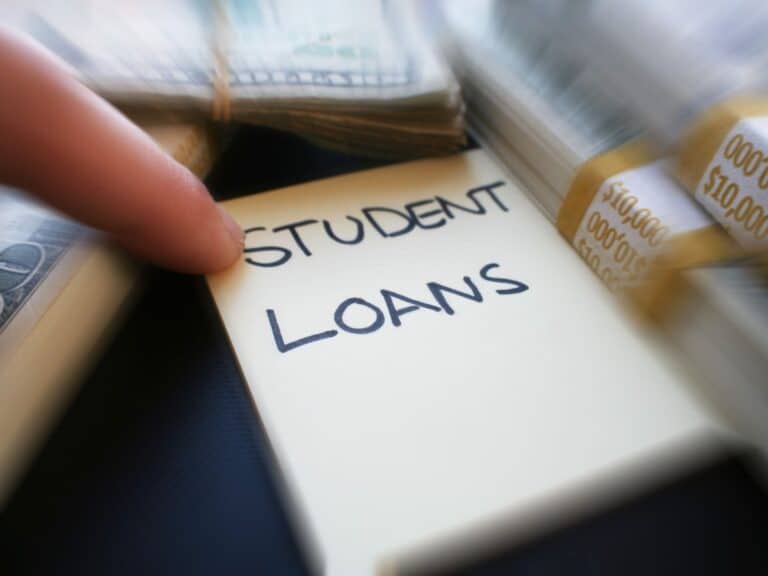Federal Loans for College
Federal loans are some of the most popular types of financial aid, and they are made by the federal government for students to use to cover various college-related costs.
The different types of federal student loans are the following:
- Federal Direct Subsidized Loan
- Federal Direct Unsubsidized Loan
- Federal Direct PLUS Loan
- Direct Consolidation Loan
Planning on applying for a federal loan instead of a private loan? Read on!
In this post, we will talk about and compare the various types of federal student loans and their advantages over private loans so that you can make a more informed and smarter choice.
What are Federal Loans?
A federal loan or a federal student loan is a type of loan offered to current and future college students (and, in some instances, parents and college graduates and those who leave college, too) by the federal government.
The US Department of Education is the one that funds federal loans.
In contrast, a private loan can come from a variety of financial institutions such as:
- Banks
- Credit unions
- State agencies
- Online lenders
- Universities
Not all students are eligible for a federal loan. Similarly, not all colleges and career schools participate in the federal aid student aid programs — it’s important to meet various requirements for eligibility for it.
Like other types of financial aid, federal student loans are designed to help cover the cost of one’s college education. However, unlike the rest, they must be repaid and with interest, too.
Other forms of financial aid that do not require borrowers to repay the federal government are:
- Loans
- Grants
- Work-study programs
To apply for federal student loans, you must fill out the Free Application for Federal Student Aid (FAFSA) form.
Based on the information you provide, the FAFSA will determine what sort of federal student loans are available to you as well as how much you can borrow under each loan for which you are eligible.
You can cancel or discontinue all or a portion of your student loan, although this has to be done before your loan is disbursed by letting your school’s Financial Aid Office know about your decision at any given time.
Let’s end this post by quickly comparing the different types of federal student loans:
| Subsidized Loan | Unsubsidized Loan | Direct PLUS | |
| Amount | Up to $12,500 | Up to $20,500 | No maximum |
| Interest rate | 5.50% | 7.05% | 8.05% |
| Repayment period | 10 to 25 years | 10 to 25 years | 10 years |
| Undergraduate students | Eligible | Eligible | Parents of undergraduates |
| Graduate students | Non-eligible | Eligible | Non-eligible |
| Professional students | Non-eligible | Eligible | Non-eligible |
Federal Direct Subsidized Loan
The Federal Direct Subsidized Loan is a type of federal loan that’s available for undergraduate students who demonstrate financial need, which, simply put, is your Expected Family Contribution (EFC).
Your EFC is how much money you and your family can reasonably be expected to use toward paying for college.
It is computed using the formula the Congress established, and it takes into account the following:
- How much money your family has
- How big your family is
- How many individuals in your family are in college
To apply for this federal loan type, you have to be an incoming or current undergraduate at an accredited college.
However, pursuing an undergraduate degree alone is not enough for you to be eligible for a Federal Direct Subsidized Loan — you must be enrolled in college at least half-time.
This means that you must maintain enrollment in at least 6 credits per semester.
You will not receive any student loan money from the federal government to pay for various college expenses if the number of credits you are taking per semester falls below 6 credits.
Besides being at least a half-time undergraduate student, it’s also important that you demonstrate financial need to be eligible to apply for the Federal Direct Subsidized Loan.
The following are the schools whose cost of attendance can be covered by the Federal Direct Subsidized Loan:
- Four-year university
- Four-year college
- Community college
- Trade school
- Technical school
- Career school
Like other federal loans, the Federal Direct Subsidized Loan comes with interest. However, it’s the US Department of Education that will pay the interest during the following:
- While you are in college at least half-time
- For the first six months after you leave college (also known as a grace period)
- During a deferment (or a postponement of loan payments)
Of course, you will be responsible for the interest once you are already out of college.
Per year, the amount of money you can borrow through a Federal Direct Subsidized Loan ranges from $5,500 to $12,500 — it will depend on your dependency status and your year level.
Similarly, how much Federal Direct Subsidized Loan you can take out will be determined by the school you are going to, and the amount should not go beyond your demonstrated financial need.
There are certain things that you can use the Federal Direct Subsidized Loan on, and they include:
- Tuition
- Fees
- Room and board
- Books
- Other college-related expenses
The fixed interest rate for the Federal Direct Subsidized Loan is determined by Congress.
Federal Direct Unsubsidized Loan
Separating the Federal Direct Unsubsidized Loan from the Federal Direct Subsidized Loan is the fact that your eligibility for it doesn’t have anything to do with you or your family’s ability to pay for college.
So, in other words, you don’t have to demonstrate financial need to take out a Federal Direct Unsubsidized Loan.
Like the Federal Direct Subsidized Loan, how much Federal Direct Unsubsidized Loan you can borrow is determined by the institution you are attending as well as other financial aid you get.
Speaking of which, you can consider taking out a Federal Direct Subsidized Loan if your Federal Direct Unsubsidized Loan money is not enough to cover the costs of college.
Different types of students may apply for the Federal Direct Subsidized Loan, and they are as follows:
- Undergraduate students
- Graduate students
- Professional students
The Federal Direct Subsidized Loan has higher loan limits, too, depending on the student.
Undergraduate students, for instance, may borrow up to $5,500 to $12,500 per year, which is the same range when it comes to how much money you can borrow on the Federal Direct Subsidized Loan.
Per year, graduate and professional students may borrow up to $20,500 of Federal Direct Subsidized Loan.
One of the perks of the Federal Direct Subsidized Loan is that the US Department of Education is the one that will take care of some of the interests until such time you are out of college.
Meanwhile, you are completely on your own when it comes to Federal Direct Unsubsidized Loan interests.
The fixed interest rate for undergraduate students is 5.50%, which is the same for undergraduates who borrow Federal Direct Subsidized Loan. For graduate and professional students, on the other hand, the fixed interest rate is 7.05%.
Federal Direct PLUS Loan
The PLUS in Federal Direct PLUS Loan stands for Parent Loan for Undergraduate Students.
As the name suggests, the Federal Direct PLUS Loan, or simply a PLUS Loan, is available to eligible parents of undergraduate students. Since the parents are the borrowers, they are responsible for repaying the Federal Direct PLUS Loan.
However, parents whose kids are attending college are not the only ones who are eligible to apply for a PLUS Loan.
Graduate and professional students may also borrow money from the Federal Direct PLUS Loan for as long as the universities they are attending are participating in the Federal Direct Loan Program.
As such, the name of the PLUS Loan can vary, depending on the borrower:
- Parent PLUS Loan if the loan is made to a parent
- Grad PLUS Loan if the loan is made to a graduate or professional student
What sets the Federal Direct PLUS Loan different from the types of loans we have discussed thus far is that it requires a credit check for all types of PLUS Loan applicants — parents and graduate or professional students alike.
Number one rule: the borrower must not have an adverse credit history.
An adverse credit history, to put it simply, is a record of poor repayment history on one or more loans or credit cards. So, in other words, when you apply for the Federal Direct PLUS Loan, a credit check will be carried out.
Someone has an adverse credit history if either of the following criteria is met:
- He or she has one or more debts with a total combined outstanding balance of greater than $2,085 that are 90 or more days delinquent as of the credit report date, or that have been placed in collection or charged off during the two years prior to the date of the credit report
- During the five years prior to the credit report date, the individual has been subjected to any of the following: a default determination, discharge of debts in bankruptcy, foreclosure or repossession, wage garnishment, tax lien or write-off of federal student aid debt
Having an adverse credit history, however, will not necessarily make an individual ineligible for the PLUS Loan — he or she may still receive money if any of the following is met:
- Obtain an endorser (someone who agrees to repay the PLUS Loan if the borrower cannot repay it, but it cannot be the child for whom the parent is borrowing) without an adverse credit history
- Document to the satisfaction of the US Department of Education that certain extenuating circumstances relating to your adverse credit history are in existence
To be eligible for the Parent PLUS Loan, the borrower must:
- Not have an adverse credit history (unless additional requirements are met)
- Be the biological or adoptive parent (or even the stepparent, in some instances) of a dependent undergraduate student enrolled at least half-time at an eligible school
- Meet the general eligibility requirements for federal student aid
On the other hand, to be eligible for the Grad PLUS Loan, the borrower must:
- Not have an adverse credit history (unless additional requirements are met)
- Be a graduate or professional student who is enrolled at least half-time at an eligible school in a program that leads to a graduate or professional degree or certificate
- Meet the general eligibility requirements for federal student aid
As to the maximum Federal Direct PLUS Loan one can borrow, it amounts to the cost of attendance, which is determined by the institution, minus any other financial assistance received.
Both the Parent PLUS Loan and Grad PLUS Loan have a fixed interest of 8.05%.
Direct Consolidation Loan
Before anything else, it’s important to point out that a direct consolidation loan is not something that will let you borrow money from the federal government to take care of your college costs.
A direct consolidation loan, instead, puts two or more qualifying federal loans into a single loan.
This means that the borrower only has to make a single payment per month instead of different ones, depending on the number of federal loans that he or she should repay every month.
Similar to any other type of federal loan, a direct consolidation loan has a fixed interest rate, which means that the interest will not change throughout the duration of the loan of the borrower.
As to how much interest he or she will have to pay per month will depend on individual federal loans combined.
The fixed interest rate is computed by determining the weighted average of the interest rates on the consolidated federal loans, after which it is rounded up to the nearest one-eighth of 1%.
Whether or not the new fixed interest rate on the direct consolidation loan is higher or lower than the interest rates on the previous federal loans will depend on the result of the said computation of direct consolidation loan interest.
As mentioned earlier only qualifying federal loans are eligible for the direct consolidation loan.
Needless to say, the ones we have discussed above — Federal Direct Subsidized Loan, Federal Direct Unsubsidized Loan, Parent PLUS Loan and Grad PLUS Loan — all qualify.
Also eligible for consolidation are other types of federal loans that we will not be discussing in this post, such as:
- Supplemental loans for students
- Nursing student loans
- Health professions student loans
- Loans for disadvantaged students
- Federal insured student loans
- Guaranteed student loans
- National direct student loans
- Auxiliary loans to assist students
Private student loans are not eligible for consolidation.
Other than simplifying the repayment process, a direct consolidation loan also makes it possible for borrowers to repay their loans for up to 30 years, thereby lowering monthly payments.
You are eligible to apply for a direct consolidation loan after:
- Graduating
- Leaving school
- Dropping below half-time enrollment
Federal vs. Private Loans
The many benefits that come with federal loans become clearer when they are contrasted against private loans. Knowing them is vital before students and parents, too, make the decision to borrow money to cover educational costs.
Let’s take a look at some of the perks of a private student loan:
Fixed Interest Rates
The interest rate of a federal loan is fixed — it will not increase at any given time throughout the duration of your loan. So, in other words, the interest will remain the same until such time that you have repaid all your educational loans.
On the other hand, private student loan interest rates may not only change with the passing of time but are also generally higher than federal loan interest rates — currently, they range anywhere from 4% to 14%.
Loan Forgiveness
In some situations, it’s possible for your federal student loans to be canceled, discharged or forgiven, which means that you won’t have to pay back either some or all of your loan/s.
Meeting certain requirements is a must to be eligible for loan forgiveness. For instance, you should work for a certain non-profit organization or in a public service type of job.
On the other hand, there is no such thing as loan forgiveness when it comes to private loans.
Income-Driven Repayment
Depending on your monthly income and family size, you can make your federal loan more manageable since monthly payments will no longer be based on your educational loan balance.
Such is what’s referred to as an income-driven repayment plan (IDR), and your balance may also be eligible for forgiveness after 20 to 25 years, depending on certain circumstances such as whether you were an undergraduate or a graduate student.
A private student loan’s repayment rates, on the other hand, do not care about a borrower’s income situation.
As a matter of fact, a private lender could attempt to collect against the estate of the borrower after he or she passes away — a federal loan, meanwhile, is discharged the minute the borrower dies.
However, there are also some disadvantages to federal student loans, and some of them are:
- Federal student loans, unlike other types of financial aid, must be repaid with interest, which remains true whether or not the borrower graduated from college and earned his or her degree
- The amount of money one can borrow per year toward his or her educational expenses is limited — in some instances, the amount is not enough to cover tuition and other college-related costs
- Federal loans have the so-called origination fees, which apply when the borrowed money is disbursed for the first time, and this can add to the overall cost of the federal student loan as well as increase one’s total educational debt
- Defaulting on a federal student loan can wreak havoc on the borrower’s credit score, which can make it difficult for him or her to obtain other types of credit in case the individual needs them
Disclaimer: The views and opinions expressed in this article are those of the authors and do not necessarily represent those of the College Reality Check.




